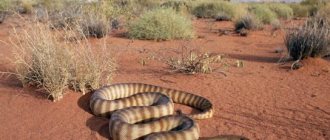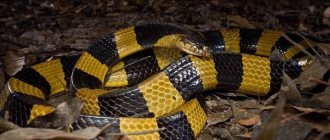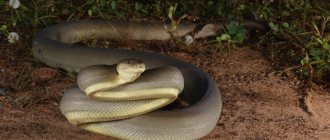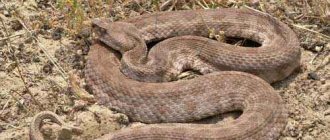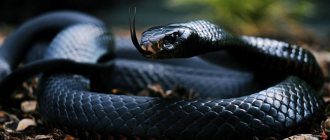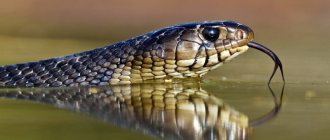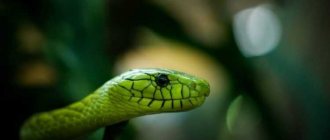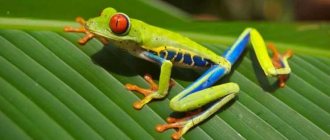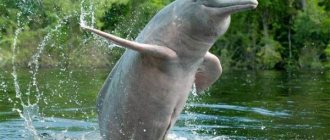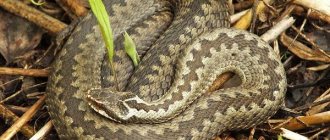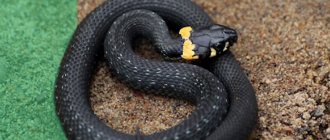About 90 species of various snakes live in Russia. Fortunately, most of them do not pose a serious danger to humans; they are small and non-poisonous. However, there are also more serious scaly ones in our forests that you should stay away from.
Unfortunately, it is impossible to name several clear signs that allow you to determine at first glance whether you have met a poisonous snake or a harmless one. Therefore, we will try together to learn to identify at least the most common representatives of this group of reptiles in our latitudes.
In winter, snakes, as everyone knows, hibernate. And as soon as the spring sun begins to shine, they wake up and become more active.
Venomous snakes have stronger venom in spring than in summer.
So, you go to an ordinary Russian forest to pick mushrooms and berries. Which snakes are you most likely to meet there?
Gyurza
The list is headed by the viper, widespread in North Africa and most of the Middle and Far East. On the territory of Russia it can be found in Dagestan. It is not for nothing that biologists classify this large snake as a genus of giant vipers: adult females reach 150 cm in length . Males are usually slightly smaller. The snake has a wide triangular head, the muzzle is rounded and blunt when viewed from above.
The head is usually evenly colored, although it may sometimes be marked with a dark V-shaped pattern. Body color can be gray, brown, beige, pinkish, olive. Against this background, a darker pattern is visible - gray, dove, reddish or brown; it can consist of a continuous pattern along the spine or two rows of large spots forming a continuous zigzag line.
This reptile is active both day and night (mainly in hot weather). It can be found both in rocky mountainous areas, and in forests, and in the steppe. She needs only two conditions - a large number of rodents and a body of water in the neighborhood. The viper is capable of making lightning-fast throws the length of its own body, breaking free from the hands of even experienced snake catchers and injecting up to 50 mg upon bite. the most dangerous poison, so it’s better not to mess with her. Snake venom has a strong hemolytic effect: it destroys blood cells and blood vessels. A victim of a viper attack feels weak and dizzy. The bitten limb swells and acquires a purplish-blue tint with foci of necrosis. Here, urgent medical attention is needed, because in case of delay, the probability of death is about 20%.
Tiger snake
The Far Eastern snake lives in wooded areas closer to water. The body length does not exceed 1.3 m. It does not produce its own poison, receiving it by eating frogs and other poisonous amphibians. After its bite, a person experiences severe bleeding from the wound, headache, nausea, and fainting. Several deaths have been reported. To prevent negative consequences, the introduction of an antidote is required.
Viper
A smaller, but more common relative of the viper in our latitudes is the viper. The common viper boasts one of the widest habitats among snakes: from the islands of Foggy Albion to the Pacific coast of Asia, from the Arctic to the Mediterranean Sea. These snakes love to live in forests and wetlands. Open glades and slopes ideal for sunbathing are important components of their preferred habitat. The rest of the time they like to hide in the thick grass. Vipers are born 16-18 cm in length and can reach up to 80 cm . The color can be varied: from light gray or brownish with a dark zigzag pattern along the back to completely black. The ventral scutes are black or gray. This snake's head is triangular and its pupils are vertical.
As a rule, in the wild they live from 10 to 15 years , although they spend a good half of this period in suspended animation. They usually hibernate from September or October, using abandoned burrows of other animals. One such shelter can contain up to hundreds of vipers. In warm climates, winter sleep time may be reduced. The viper is mainly diurnal, especially in the northern part of its habitat. But the further south you go, the more active it is in the evening and at night.
A viper bite is usually not fatal to an adult, but is dangerous to children and pets. In any case, after a bite you should immediately seek professional medical help, otherwise even healthy adults may experience unpleasant consequences of exposure to the poison for up to several months.
Symptoms of a pit viper bite include immediate and severe pain, swelling and a tingling sensation. Further symptoms may include nausea, abdominal colic and diarrhea, urinary incontinence, sweating, fever, vasoconstriction, tachycardia, loss of consciousness, temporary blindness, swelling of the face, lips, gums, tongue, and throat. In severe cases, cardiovascular failure may develop. If left untreated, these symptoms may persist for up to 48 hours.
It is important to remember: the most poisonous snakes that are common in Russia
Viper
The viper is one of the most poisonous snakes living in our country. There are several species of reptiles of this family:
- common, found in almost every corner of Russia in forests and swamps. The snake, reaching up to 80 cm in length, is colored in light and dark shades of gray with a characteristic zigzag pattern on its body.
- steppe, living in the steppes and forest-steppes of the European part of Russia, on sea coasts, in bushes, on mountain slopes, in meadow floodplains and ravines. The snake is colored brownish-gray, a dark zigzag stretches along the ridge, and dark, non-contrasting spots stand out on the sides.
- Caucasian, well known to residents of the Krasnodar Territory and the South Caucasus. The snake lives in river valleys, forests, subalpine and alpine meadows, and on the Black Sea coast. On the body of the viper there is a bright pattern ranging from yellow-orange to brick-red. The head is wide with an upturned nose and temporal swellings.
When meeting a person, vipers, as a rule, try to hide. If the escape route is cut off or the snake feels threatened, it may attack. The viper takes a defensive position, hisses, and makes throws.
A snake bite causes severe pain and swelling. Later, nausea, colic, diarrhea, urinary incontinence, fever, tachycardia, fainting, and blurred vision may appear.
In severe cases, cardiovascular failure develops, swelling of the throat with respiratory arrest, although cases of death as a result of a viper bite are rare.
Lizard snake
A reptile bite is painful, but most often harmless. The fact is that the teeth with paralyzing poison are located deep in the snake’s mouth and when it bites a person, it is purely mechanically unable to use them. But for small children and pets, an encounter with a lizard snake can have disastrous consequences.
Cottonmouth
The victim experiences severe pain, hemorrhages, and breathing problems. With a successful outcome, the symptoms disappear within a week, but dental wounds may not heal for more than a month.
Gyurza
The viper is a large snake from the genus of giant vipers (females can reach 1.5 m in length). It is painted grayish-sandy or reddish-brown. The body is dense and strong.
You can meet viper in the mountainous regions of the Caucasus. The snake is very poisonous and has more courage than the viper. Sensing danger, she attacks with lightning speed, making a sharp throw - almost equal to the length of her body.
When bitten, the viper injects up to 50 mg of toxic poison, which has a hemolytic effect and destroys red blood cells and blood vessels.
The affected area immediately swells and turns blue. The person feels weak and dizzy. When bitten by a viper, special serum and medical care are required - in 20% of cases such contact can be fatal.
Tiger snake
In the presence of poison, the tiger snake becomes more decisive and, in defense, can make attacks towards the enemy. A non-venomous snake prefers to quickly hide.
Like a lizard snake, the teeth with poisonous glands are located too deep in snakes, so there are few cases in which a person was seriously injured by a bite, and there is still no accurate data on the effect of the poison on the body.
This is interesting: What type of crocodiles is the largest and most dangerous on Earth?
Caucasian viper
The Caucasian viper, also known as Kaznakov's viper, is a much rarer, but also more dangerous species of viper. It is endemic to the Caucasus, living in Russia, Georgia and Turkey. This snake reaches a length of up to 60 cm , the wedge-shaped head is visually different from the neck. Unlike the modest colors of other vipers, the color of the Caucasian viper has pronounced reddish and orange elements. Along the spine there is a wide, black or brown zigzag stripe. Juveniles boast a bright red-brown color, reaching maximum intensity after the first winter. Melanists are very rare.
This species lives on wooded mountain slopes, in wet ravines and on the edges of clearings. On the Black Sea coast it emerges from hibernation in March, but at altitudes above 600 m above sea level it appears in the second half of April or early May. Breeds from late March to mid-May. Hibernation begins in early November (for coastal areas), and at the end - beginning of October for high-mountain populations.
The Caucasian viper can live at an altitude of up to 900 meters above sea level. Even higher (up to 3000 meters above sea level) lives a snake similar in appearance and biology, described as a separate species only at the end of the 20th century - Dinnik’s viper.
Two-color bonito
The snake, not exceeding 1 m in length, lives in the Sea of Japan and does not come onto land. It practically does not interact with people; no cases of attack have been recorded. But if this does happen, then the probability of death is very high. The glands of the bicolor bonito contain a poison more toxic than that of the cobra.
Steppe viper
The steppe viper is a venomous snake that lives from southeastern France to China. The length of its body reaches 50 cm .
Most often found in open grasslands and hillsides, well-drained rocky mountain slopes, although it can also be found in wet meadows and marshy areas. It is similar in color to the common viper: its light gray or brown body is decorated with intricate zigzags and spots on the sides. Its head has a slightly elongated shape, and the edges of its muzzle are raised. The snake is active from April - May to November and leaves its winter refuge no earlier than the temperature rises above 5-8 C. The consequences of a bite by a steppe viper are similar to the consequences of a bite by a common viper.
Non-poisonous, but with character
Caspian or yellow-bellied snake
WHERE IT LIVES: in the steppes of Zaporozhye, Kirovograd, Nikolaev, Odessa regions.
HOW TO RECOGNIZE: The body is slender, with a long tail, smooth scales. In adult snakes, the upper side of the body is gray or brownish, the lower side is straw-yellow, without any spots. Juveniles have a characteristic pattern.
WHAT IS DANGEROUS: A very mobile and aggressive snake, it does not hide when it sees a person, but prepares to attack, it can “jump” towards the enemy at a distance of up to one meter, it targets the head and neck area, it is not poisonous, but the bite can be strong.
WHAT IS USEFUL: Destroys rodents. Listed in the Red Book.
Common cottonmouth
Another poisonous snake living in Russia is the common copperhead, also known as Pallas's copperhead. An interesting feature of this snake is that it is able to capture the thermal radiation of its prey. It has a dull coloration, grayish or brown, with transverse dark spots along the back and smaller markings on the sides. The tip of the wide muzzle is slightly upturned, and between the nostrils and the eyes of the copperhead there are noticeable indentations: its heat-sensitive organs are located there. Body length is up to 70 cm .
The cottonmouth is found in Central Asia, Northern China, Korea and Mongolia. Within Russia, it can be found in the Lower Volga region, Southern Siberia and the Far East.
When choosing a place of residence, the copperhead is unpretentious. Forests and steppes, semi-deserts and subalpine meadows, banks and swampy floodplains of rivers are suitable for him. He is also indiscriminate in his daily routine: he can be active both day and night. The bite of the copperhead is usually not fatal, although it is dangerous if you have heart and kidney problems. Like viper venom, copperhead venom disrupts the circulatory system, but it also contains neurotoxins. It usually causes a rather severe condition that can last a whole week. And the bite wound sometimes does not heal for more than a month.
Yellowbelly
The body length varies around 1 m. The back is colored either olive or black, but the belly is always yellowish (hence the name).
These snakes live far from people, preferably in fields and steppes. But there are cases of settlement in city gardens and parks.
Their food is small birds or rodents. Meeting a random passer-by does not bode well.
Florence Pugh has spoken out harshly against those who criticize her personal life
May 12 Nurse's Day: a 200-year-old holiday is more relevant today than ever
I’ll watch it just for the sake of the dog: is it worth spending time on the series “Katya and Black”
Its bites are very painful and take a very long time to heal. Favorite wintering places are haystacks or burrows, the owners of which the yellowbelly has previously eaten.
Snakes of this species are very attached to their habitat, so they always return to it after any event, be it hunting or mating games.
copperhead
The copperhead is a snake whose dangers are talked about much more than it deserves. Its habitat extends throughout Europe to Western Siberia. It belongs to the order of colubrids, although in appearance it resembles a viper. The color of the copperhead is matte gray, brown or brick-reddish with a dark, sometimes very faint pattern along the back. She usually has a marking on her head that is sometimes described as a "butterfly" or "heart". Another characteristic feature is dark stripes running horizontally along the eye line. The pupils of this snake are round, unlike the viper's, and the irises of the eyes may be reddish.
In principle, the copperhead is safe for humans, although it can bite until it bleeds with its front, non-poisonous teeth. The poisonous teeth are located too deep in the mouth, so they are dangerous only for the prey that the copperhead can immediately swallow. In addition, it produces little poison, and it is much less toxic than viper.
Multi-colored snake
This one and a half meter snake lives in the North Caucasus, often close to people: in gardens, attics and roofs of houses. Has an aggressive character. When meeting a person, it hisses and rushes towards him. If a colorful snake manages to bite, its toxic saliva may enter the bloodstream, causing local poisoning of the body. All symptoms go away on their own after 2-4 days.
What to do if bitten by a snake?
If you are bitten by a poisonous snake, it is best to consult a doctor as soon as possible. Other measures to take:
- If possible, suck out the poison from the wound, periodically rinsing your mouth with water (this measure is effective during the first 5-10 minutes). Be careful, if there are wounds in your mouth, there is a risk of poison getting into your mouth, do not swallow it under any circumstances!
- Immobilize the affected part of the body.
- Remove anything that might put pressure on the limb during swelling.
- Drink more - this will help remove poison from the body.
You should never do the following:
- Cauterize or widen the wound: as a result of the bite, the poison enters a depth of several centimeters and cannot be gotten rid of in this way.
- Apply a tourniquet: this can lead to necrosis and subsequent amputation.
- Drink alcohol: it will slow down the elimination of poison from the body.
- Drink coffee: its stimulating effect will be unnecessary.
Context
Over the 7 months of 2022, 14 residents of the region required medical assistance after being bitten by reptiles. In 2016, 16 people were bitten by snakes, and 12 in 2015. There have been no deaths from snake bites since 2007.
The Regional Health annually monitors and checks the presence of anti-snake serum in medical institutions in the region. Emergency medical care after a snake bite can be obtained not only in Voronezh (OKB No. 1 and ODKB No. 1), but also in regional hospitals.

